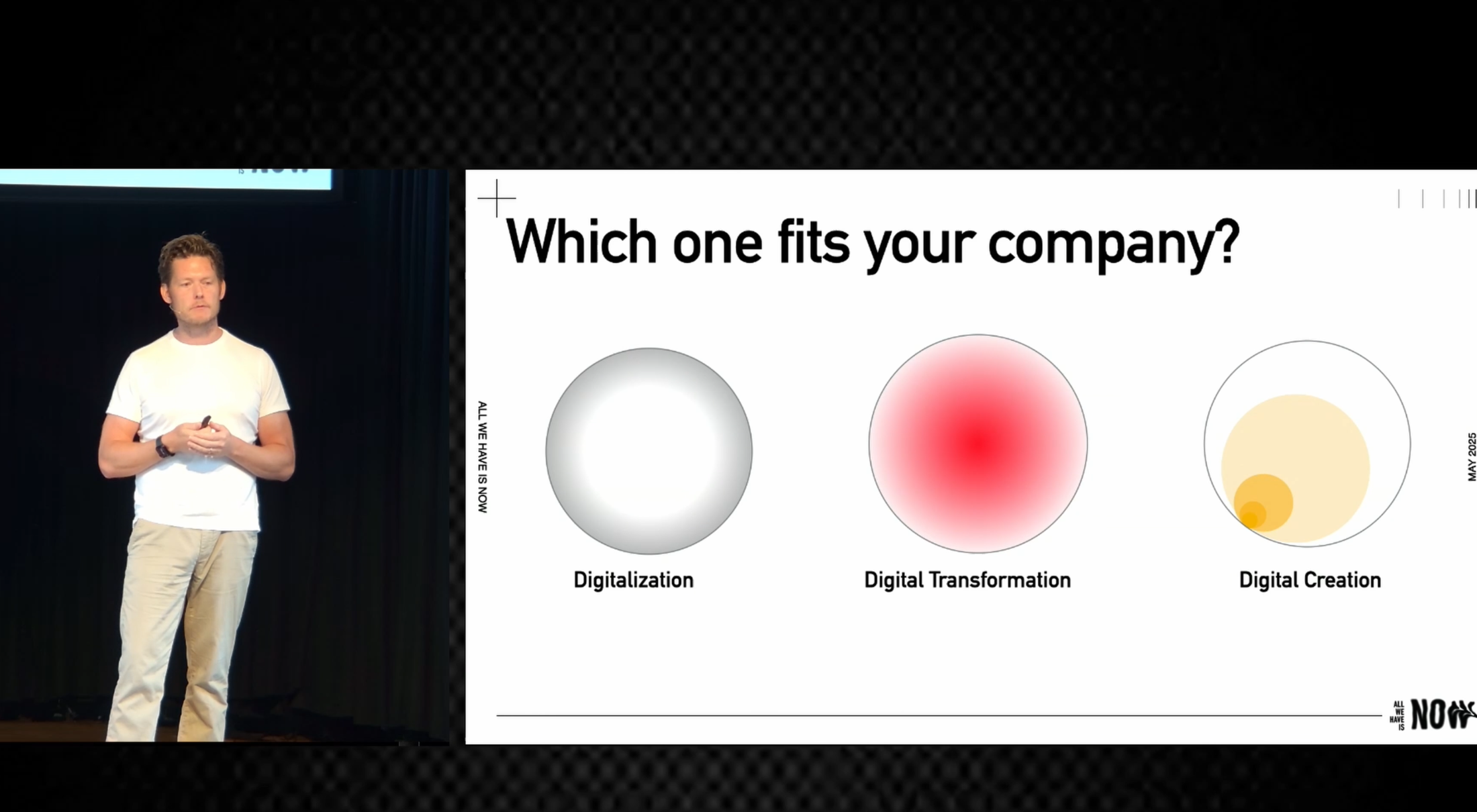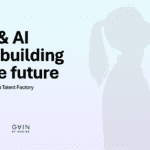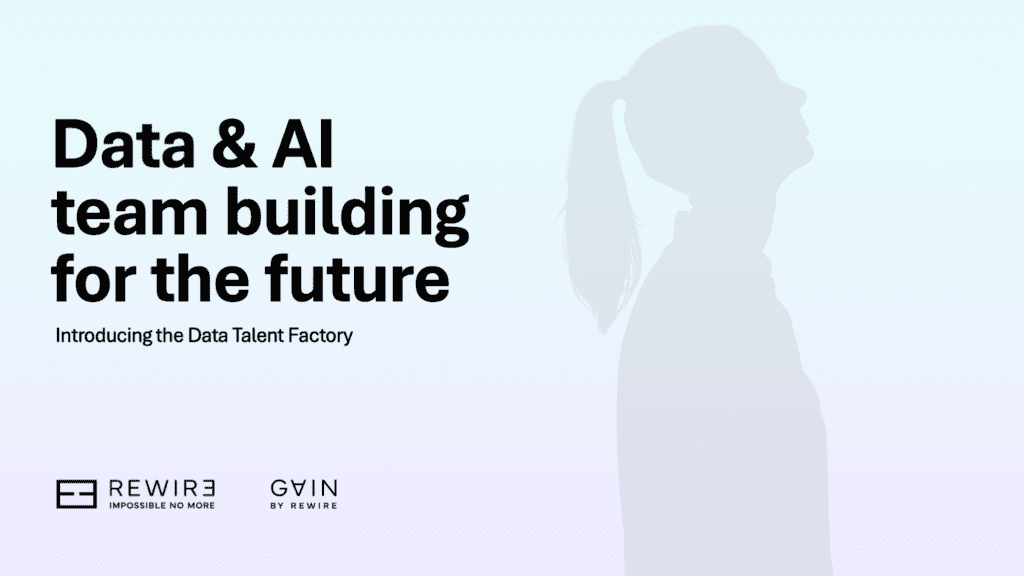Technology and innovation expert Tom Goodwin on the merits of GenAI and how to leverage its potential.

During Rewire LIVE, we had the pleasure of hosting Tom Goodwin, a friend of Rewire and pragmatic futurist and transformation expert who advises Fortune 500 companies on emerging technologies such as GenAI. Over the past 20 years, he has studied the impact of new technology, new consumer behaviors and the changing rules of business, which makes him uniquely suited to understand the significance of GenAI today.
At the core of Tom’s thinking lies a question that all leaders should ponder: if, knowing everything you know now, were to build your company from scratch, what would it look like? At times counter-intuitive, Tom’s insights, steeped in history, provide valuable clues to answer this question. In this article, we share a handful of them.
INSIGHT 1: Technology revolution happens in two stages. In the first stage we add to what was done before. In the second stage we rethink. That’s when the revolution really happens.
Tom’s insight is derived from the Perez Framework, developed by Carlota Perez, a scholar specialized in technology and socio-economic development. The framework – based on the analysis of all the major technological revolutions since the industrial revolution – stipulates that technological revolutions first go through an installation phase, then a deployment stage. In the installation phase, the technology comes to market and the supporting infrastructure is built. In the deployment phase, society fully adopts the technology. (The transition between the two phases is typically marked by a financial crash and a recovery.)
During the first phase, there’s a frenzy – not dissimilar to the hype that currently surrounds GenAI. Everyone jumps on the technology, everyone talks about it. However, nothing profound really changes. For the most part, the technology only adds to the existing ways of doing things. In contrast, during the second stage, people finally make sense of the technology and use it to rethink the way things are done. That’s when the value is unleashed.
Take electricity as an example. In the first stage, electricity brought the electric iron, the light, the fan, the oven. These were all things that existed before. In the second stage, truly revolutionary innovations emerged: the radio, the TV, the telephone, the microwave, the microwave dinner, factories that operate 24/7, and so on. The second stage required a completely different mindset vis-à-vis what could do be done and how people would behave.
This begs the question: what will be the second stage of GenAI – and more broadly AI – be? What will be the telephone, radio, microwave for AI? Tom’s assertion here is that the degree of transformation is less about how exciting that technology is, and it’s much more about how deeply you change. Better AI will be about systems that are completely rethought and deep integrations, rather than UI patches.
Watch the video clip.
INSIGHT 2: Having category expertise, knowing how to make money, having relationships, and having staff who really know what they’re doing is probably more important than technology expertise.
Across many industries, battle lines are drawn between large traditional companies that have been around for a long time and the digitally-enabled, tech first, mobile-centric startup types. Think Airbnb vs Marriott, Tesla vs. BMW, SpaceX vs NASA, and so on.
The question is who’s going to win. Is it the digitally native companies who have created themselves for the modern era? Or is it the traditional companies that have been around for a long time? Put another way, is it easiest to be a tech company and learn how to make money in your target industry? Or be a big company who already knows how to make money but must now understand what a technology means and adapt accordingly?
Up until recently, the assumption was that the tech companies would win the battle. This proved true for a while: Netflix vs. Blockbusters, Apple vs. Nokia, etc. The assumption was that this would carry on. Understanding the technology was more important than understanding the category.
Tom’s observation is that in the past four years, these assumptions have been challenged. For example, traditional banks have got really good at understanding technology. Neobanks might be good at getting millennials to share the cost of a pizza, but they’re not that good at making money. So there’s this slow realisation that maybe digital-first tech companies are not going to win – because big companies are getting pretty good at change.
Taking a step back, it seems that the narrative of disrupt or die isn’t always true: a lot of the rules of business have not changed; incumbents just need to get a bit more excited about technology. Ultimately, having category expertise, knowing how to make money, having relationships, and having staff who really know what they’re doing is probably more important than tech expertise.
Watch the video clip.
INSIGHT 3: The AI craze is enabling a more flexible investment climate. This is an incentive for leaders to be bold.
Generative AI has spurn heated debates about the evolution of AI and divided experts and observers into two opposing groups: the AI cheerleaders and the sceptics. The former believe that AI is going to change everything immediately. The latter think that it’s a bubble.
History is littered with innovations that went nowhere. A handful of them however proved to be transformational – if in the long run. Only time will tell which group GenAI will join. In the meantime, there’s a growing realization that significant investment may be required to make meaningful steps with AI, hence a more flexible climate for capex – which is an incentive for leaders to be bold.
Tom’s insight reflects this situation: change is hard and expensive, and so regardless of one’s position in the debate, GenAI provides a unique window of opportunity to get the investor that you wouldn’t normally get. It is an amazing time to have an audience who normally wouldn’t listen to you.
Conclusion
These were but a handful of the many insights that Tom shared with us during Rewire LIVE. Taking a step back, it is clear that we are far from having realized the full value of GenAI – and, more broadly, AI. In the words of Tom, AI is a chance to dream really big and leave your mark on the world. It is yours for grab.
About Tom Goodwin
Tom Goodwin is the four time #1 in “Voice in Marketing” on LinkedIn with over 725,000 followers on the platform. He currently heads up “All We Have Is Now”, a digital business transformation consultancy, working with Clients as varied as Stellantis, Merck, Bayer, and EY to rethink how they use technology.
Tom hosts “The Edge” a TV series focusing on technology and innovation, and “My Wildest Prediction”, a podcast produced and distributed by Euronews. He has published the book “Digital Darwinism” with Kogan Page, and has spoken in over 100 cities across 45 countries.
With a 23 year career that spans creative, PR, digital and media agencies, Tom is an industry provocateur as a columnist for the Guardian, TechCrunch and Forbes and frequent contributor to GQ, The World Economic Forum, Ad Age, Wired, Ad Week, Inc, MediaPost and Digiday.
To find out more about Tom, visit www.tomgoodwin.co
![[Video] Generative AI: act now or wait for proof of value?](https://rewirenow.com/app/uploads/2024/09/matt-noble-BpTMNN9JSmQ-unsplash-1024x683.jpg)



